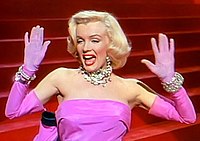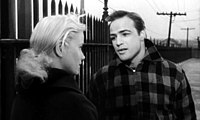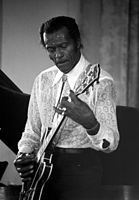1950s: Difference between revisions
→Science: rw |
Tag: section blanking |
||
| Line 13: | Line 13: | ||
Clashes between communism and capitalism dominated the decade, especially in the Northern Hemisphere. The conflicts included the [[Korean War]] and the beginning of the [[Space Race]] with the launch of [[Sputnik I]]. Along with increased testing of nuclear weapons (such as [[RDS-37]] and [[Operation Upshot-Knothole|Upshot-Knothole]]), this created a politically conservative climate.{{Citation needed|date=October 2009}} In the United States, the [[Red Scare]] (fear of [[communism]]) caused public Congressional hearings by both houses in [[U.S. Congress|Congress]] and [[Anti-Communism]] was the prevailing sentiment in the United States throughout the decade (this is what primarily led the country to intervene in the [[Korean War]] and later the [[Vietnam War]]). The beginning of [[decolonization]] in [[Africa]] and [[Asia]] occurred in this decade and accelerated in the following decade, the 1960s. The 1950 congressional seminar gave way to the new focus of contention between communist and capitalist ideology. This created multiple instances of terminal interests, but never became an open conflict. |
Clashes between communism and capitalism dominated the decade, especially in the Northern Hemisphere. The conflicts included the [[Korean War]] and the beginning of the [[Space Race]] with the launch of [[Sputnik I]]. Along with increased testing of nuclear weapons (such as [[RDS-37]] and [[Operation Upshot-Knothole|Upshot-Knothole]]), this created a politically conservative climate.{{Citation needed|date=October 2009}} In the United States, the [[Red Scare]] (fear of [[communism]]) caused public Congressional hearings by both houses in [[U.S. Congress|Congress]] and [[Anti-Communism]] was the prevailing sentiment in the United States throughout the decade (this is what primarily led the country to intervene in the [[Korean War]] and later the [[Vietnam War]]). The beginning of [[decolonization]] in [[Africa]] and [[Asia]] occurred in this decade and accelerated in the following decade, the 1960s. The 1950 congressional seminar gave way to the new focus of contention between communist and capitalist ideology. This created multiple instances of terminal interests, but never became an open conflict. |
||
== Wars and conflicts == |
|||
{{Expand section|date=January 2010}} |
|||
[[File:Koreanwarmontage.jpg|right|thumb|[[Korean War]]]] |
|||
[[File:Israeli troops in sinai war.jpg|thumb|Israeli troops preparing for combat in the Sinai peninsula during the [[Suez Crisis]].]] |
|||
* [[Cold War]] conflicts involving the influence of the rival superpowers of the [[Soviet Union]] and the United States: |
|||
** [[Korean War]] (1950–1953) - The war, which lasted from June 25, 1950 until the signing of the [[Korean Armistice Agreement]] on July 27, 1953, started as a [[civil war]] between [[North Korea]] and the Republic of Korea ([[South Korea]]). When it began, North and South Korea existed as provisional governments competing for control over the Korean peninsula, due to the [[division of Korea]] by outside powers. While originally a civil war, it quickly escalated into a war between the western powers under the [[United Nations Command]] led by the United States and its allies and the communist powers of the People's Republic of China and the Soviet Union. On September 15, General [[Douglas MacArthur]] conducted an [[Operation Chromite|amphibious landing at the city of Inchon]] (Song Do port). The North Korean army collapsed, and within a few days, MacArthur's army retook [[Seoul]] (South Korea's capital). He then pushed north, capturing Pyongyang in October. Chinese intervention the following month drove UN forces south again. MacArthur then planned for a full-scale invasion of China, but this was against the wishes of President Truman and others who wanted a limited war. He was dismissed and replaced by General Matthew Ridgeway. The war then became a bloody stalemate for the next two and a half years while peace negotiations dragged on. The war left 33,742 American soldiers dead, 92,134 wounded, and 80,000 Missing in action (MIA) or [[Prisoner of war|Prisoners of war (POW)]]. Estimates place [[Korean War#Aftermath: Operation Glory|Korean and Chinese casualties]] at 1,000,000–1,400,000 dead or wounded, and 140,000 MIA or POW. |
|||
** The [[Vietnam War]] began in 1959. Diem instituted a policy of death penalty against any communist activity in 1956. The Vietcong began an assassination campaign in early 1957. An article by French scholar [[Bernard Fall]] published in July 1958 concluded that a new war had begun. The first official large unit military action was on September 26, 1959, when the Vietcong ambushed two ARVN companies.<ref>[http://www.mtholyoke.edu/acad/intrel/pentagon/pent14.htm The Pentagon Papers, Volume 1, Chapter 5, Section 3, "Origins of the Insurgency in South Vietnam, 1954-1960"]</ref> |
|||
* [[Arab–Israeli conflict]] (Early 20th century-present) |
|||
** [[Suez Crisis]] (1956) - The [[Suez Crisis]] was a [[war]] fought on [[Egypt]]ian territory in 1956. Following the nationalisation of the [[Suez Canal]] in 1956 by [[Gamal Abdel Nasser]], the United Kingdom, France and [[Israel]] subsequently invaded. The operation was a military success, but after the United States and [[Soviet Union]] united in opposition to the invasion, the invaders were forced to withdraw. This was seen as a major humiliation, especially for the two Western European countries, and symbolizes the beginning of the end of colonialism and the weakening of European global importance, specifically the collapse of the [[British Empire]]. |
|||
* [[Algerian War]] (1954–1962) - An important [[decolonization]] war, it was a complex conflict characterized by [[guerrilla warfare]], [[maquis (World War II)|maquis]] fighting, [[terrorism]] against civilians, use of [[torture]] on both sides and [[counter-terrorism]] operations by the [[French Army]]. The war eventually led to the independence of [[Algeria]] from [[France]]. |
|||
=== Internal conflicts === |
|||
[[File:Fidel Castro - MATS Terminal Washington 1959.jpg|thumb|right|150px|[[Fidel Castro]] becomes the leader of Cuba as a result of the [[Cuban Revolution]]]] |
|||
* [[Cuban Revolution]] (1953–1959) - The 1959 overthrow of [[Fulgencio Batista]] by [[Fidel Castro]], [[Che Guevara]] and other forces resulted in the creation of the first [[Communism|communist]] government in the western hemisphere. |
|||
* The [[Mau Mau]] began retaliating against the British in Kenya. This led to [[concentration camps]] in Kenya, the retreat of the British, and the election of [[Jomo Kenyatta]] as leader of Kenya. |
|||
* The [[wind of destruction]] began in Rwanda in 1959, following the beating up of [[Hutu]] politician [[Dominique Mbonyumutwa]] by [[Tutsi]] forces. This was the beginning of decades of ethnic violence in the country, which culminated in the [[1994 Rwandan Genocide]]. |
|||
=== Decolonization and Independence === |
|||
* [[Decolonization]] of former European [[Colonial empire]]s. The [[French Fourth Republic]] in particular faced conflict on two fronts within the [[French Union]], the [[Algerian War]] and the [[First Indo-china War]]. [[French Algeria|French rule]] ended in [[Algeria]] in 1958, [[Vietnam]] left [[French Indo-china]] in 1954. The rival states of [[North Vietnam]] and [[South Vietnam]] were formed. [[Cambodia under Sihanouk (1954–1970)|Cambodia]] and the [[Kingdom of Laos]] also gained independence, effectively ending French presence in [[Southeast Asia]]. Elsewhere the [[Belgian Congo]] and other African nations gained their independence from France, [[Belgium]] and the [[United Kingdom]]. |
|||
* Large-scale [[decolonization]] in Africa first began in the 1950s. In 1951, [[Libya]] became the first African country to gain independence in the decade, and in 1954 the [[Algerian War]] began. 1956 saw [[Sudan]], [[Morocco]], and [[Tunisia]] become independent, and the next year [[Ghana]] became the first [[sub-saharan Africa]]n nation to gain independence. |
|||
=== Prominent political events === |
|||
{{Expand section|date=January 2010}} |
|||
* [[European Common Market]] - The [[European Communities]] (or Common Markets), the precursor of the [[European Union]], was established with the [[Treaty of Rome]] in 1957. |
|||
* On November 1, 1950, two Puerto Rican nationalists staged an attempted assassination on [[President Harry Truman]]. The leader of the team [[Griselio Torresola]] had fire arm experience and [[Oscar Collazo]] was his accomplice. They made their assault at the [[Blair House]] where President Truman and his family where staying. Torresola mortally wounded a White House policeman, [[Leslie Coffelt]], who shot Torresola dead before expiring himself. Collazo, as a co-conspirator in a felony that turned into a homicide, was found guilty of murder and was sentenced to death in 1952 but then his sentence was later commuted to life in prison.. |
|||
== International issues == |
== International issues == |
||
Revision as of 20:16, 24 January 2011
This article has multiple issues. Please help improve it or discuss these issues on the talk page. (Learn how and when to remove these messages)
No issues specified. Please specify issues, or remove this template. |
| Millennium |
|---|
| 2nd millennium |
| Centuries |
| Decades |
| Years |
| Categories |
The 1950s was the decade that began on January 1, 1950 and ended on December 31, 1959. The decade was the sixth decade of the 20th century. By its end, the world had largely recovered from World War II and the Cold War developed from its modest beginning in the late 1940s to a hot competition between the United States and the Soviet Union by the beginning of the 1960s.
Clashes between communism and capitalism dominated the decade, especially in the Northern Hemisphere. The conflicts included the Korean War and the beginning of the Space Race with the launch of Sputnik I. Along with increased testing of nuclear weapons (such as RDS-37 and Upshot-Knothole), this created a politically conservative climate.[citation needed] In the United States, the Red Scare (fear of communism) caused public Congressional hearings by both houses in Congress and Anti-Communism was the prevailing sentiment in the United States throughout the decade (this is what primarily led the country to intervene in the Korean War and later the Vietnam War). The beginning of decolonization in Africa and Asia occurred in this decade and accelerated in the following decade, the 1960s. The 1950 congressional seminar gave way to the new focus of contention between communist and capitalist ideology. This created multiple instances of terminal interests, but never became an open conflict.
International issues
- Establishment of the Non-aligned Movement, consisting of nations not formally aligned with or against any major power bloc.
Africa
- Africa experienced the beginning of large-scale top-down economic interventions in the 1950s that failed to cause improvement and led to charitable exhaustion by the West as the century went on. The widespread corruption was not dealt with and war, disease, and famine continued to be constant problems in the region.
- Egyptian general Gamel Abdel Nasser overthrew the Egyptian monarchy, establishing himself as President of Egypt. Nasser became an influential leader in the Middle East in the 1950s, leading Arab states into war with Israel, becoming a major leader of the Non-Aligned Movement and promotingpan-Arab unification.
Americas
- In the 1950s Latin America was the center of covert and overt conflict between the Soviet Union and the United States. Their varying collusion with national, populist, and elitist interests destabilized the region. The United States CIA orchestrated the overthrow of the Guatemalan government in 1954. In 1958 the military dictatorship of Venezuela was overthrown. This continued a pattern of regional revolution and warfare making extensive use of ground forces.
- In 1957, Dr. François Duvalier came to power in an election in Haiti. He later declared himself president for life, and ruled until his death in 1971.
- In 1959 Fidel Castro overthrew the regime of Fulgencio Batista in Cuba, establishing a communist government in the country. Although Castro initially sought aid from the US, he was rebuffed and later turned to the Soviet Union.
- NORAD signed in 1959 by Canada and the United States creating a unified North American aerial defense system.
- Brasília was built in 41 months, from 1956, and on April 21, 1960, became the capital of Brazil
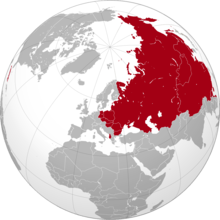
Asia
- Reconstruction continued in Japan in the 1950s, funded by the United States, which ended its occupation of the country in 1951. Social changes took place, including democratic elections and universal suffrage.
- Within a year of its establishment, the People's Republic of China had invaded Tibet and intervened in the Korean War, causing years of hostility and estrangement from the United States. The Chinese allied with the Soviet Union, which then provided considerable technical and economic aid. Although relations between the two communist giants remained friendly throughout the 1950s, cracks were forming in their alliance by the end of the decade. The Great Leap Forward in 1958–1960 was an attempt by Mao Zedong to rush the country's economic development with the creation of huge rural communes. It failed ignominiously, and combined with a series of natural disasters triggered an enormous famine in which several million people died.
- In 1953 the French colonial rulers of Indochina tried to contain a growing communist insurgency against their rule led by Ho Chi Minh. After their defeat at Dien Bien Phu in 1954 they were forced to cede independence to the nations of Cambodia, Laos and Vietnam. The Geneva Conference of 1954 separated French supporters and communist nationalists for the purposes of the ceasefire, and mandated nationwide elections by 1956; Ngo Dinh Diem established a government in the south and refused to hold elections. Conflict then resumed between the communist north and American-supported south .
Europe
With the help of the Marshall Plan, post-war reconstruction succeeded, with some countries (including West Germany) preferring free market capitalism while others preferred Keynesian-policy welfare states. Europe continued to be divided into Western and Soviet bloc countries. The geographical point of this division came to be called the Iron Curtain. It divided Germany into East and West Germany. In 1955 West Germany joined NATO.
The Soviet Union continued its domination of eastern Europe. In 1953 Joseph Stalin, the leader of the Soviet Union, died. This led to the rise of Nikita Khrushchev, who denounced Stalin and pursued a more liberal domestic and foreign policy, stressing peaceful competition with the West rather than overt hostility. There were anti-Soviet uprisings in East Germany and Poland in 1953.
Disasters
This section needs expansion. You can help by adding to it. (February 2010) |

- On 15 August 1950 an earthquake and floods in Assam, India killed 574 and leave 5,000,000 homeless.
- Mount Lamington erupted in Papua New Guinea on 18 January 1951, killing 3,000 people.
- On 31 January 1953 the North Sea flood of 1953 killed 1,835 people in the southwestern Netherlands (especially Zeeland) and 307 in the United Kingdom[1]
- On 9 September 1954 an earthquake centered on the city of Orleansville, Algeria killed 1,500 and left thousands homeless.
- On 11 October 1954 Hurricane Hazel crossed over Haiti, killing 1,000.
- On 19 August 1955 Hurricane Diane hit the northeastern United States, killing over 200 people, and causing over $1.0 billion in damage.
- On 27 June 1957 Hurricane Audrey demolished Cameron, Louisiana, US, killing 400 people.
- Typhoon Vera hit central Honshū on 26 September 1959, killing an estimated 5,098, injuring another 38,921, and leaving 1,533,000 homeless. Most of the damage was centered in the Nagoya area.
- On 2 December 1959, Malpasset Dam in southern France collapsed and water flowed over the town of Frejus, killing 412.
Economics
This section is empty. You can help by adding to it. (January 2010) |
Science and technology
Technology


- Charles H. Townes builds the Maser in 1953 at the Columbia University.
- The Soviet Union launches Sputnik 1, the first artificial satellite to orbit the earth on October 4, 1957.
- The United States conducts its first hydrogen bomb explosion test.
- The invention of the Transistor.
- The invention of the Solar cell.
- Passenger jets enter service.
Science
- Francis Crick and James Watson discover the spiral structure of DNA.
- An immunization vaccine is produced for polio.
- The first successful ultrasound test of the heart activity.
- The CERN is established.
- The world's first nuclear power plant is opened in Obninsk near Moscow.
- NASA is organized.
- President Harry Truman inaugurated transcontinental television service on September 4, 1951 when he made a speech to the nation. AT&T carried his address from San Francisco and it was viewed from the west coast to the east coast at the same time.
Popular culture
Music
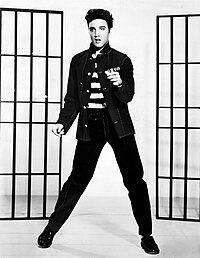
Rock-n-Roll emerged in the mid-50s as the teen music of choice with Sam Cooke, Jackie Wilson, Gene Vincent, Chuck Berry, Fats Domino, Little Richard, James Brown, Bo Diddley, Buddy Holly, Bobby Darin, Ritchie Valens, Duane Eddy, Eddie Cochrane, Brenda Lee, Bobby Vee, Connie Frances, Johnny Mathis, Pat Boone and Ricky Nelson being notable exponents. In the mid-1950s, Elvis Presley became the leading figure of the newly popular sound of rock and roll with a series of network television appearances and chart-topping records. Chuck Berry, with "Maybellene" (1955), "Roll over Beethoven" (1956), "Rock and Roll Music" (1957) and "Johnny B. Goode" (1958), refined and developed the major elements that made rock and roll distinctive, focusing on teen life and introducing guitar solos and showmanship that would be a major influence on subsequent rock music.[2] Bill Haley, Jerry Lee Lewis, the Everly Brothers, Carl Perkins, Johnny Cash, Conway Twitty, Johnny Horton, and Marty Robbins were Rockabilly musicians. Doo Wop was another popular genre at the time. Popular Doo Wop and Rock-n-Roll bands of the mid to late 1950s include The Platters, The Flamingos, The Dells, The Silhouettes, Frankie Lyman and The Teenagers, Little Anthony & The Imperials, Danny and the Juniors, The Coasters, The Drifters, The Del-Vikings and Dion and the Belmonts.
Jazz stars in the 1950s who came into prominence in their genres called Bebop, Hard bop, Cool jazz and the Blues, at this time included Lester Young, Ben Webster, Charlie Parker, Dizzy Gillespie, Miles Davis, John Coltrane, Thelonious Monk, Charles Mingus, Art Tatum, Bill Evans, Ahmad Jamal, Oscar Peterson, Gil Evans, Jerry Mulligan, Cannonball Adderley, Stan Getz, Chet Baker, Dave Brubeck, Art Blakey, Max Roach, the Miles Davis Quintet, the Modern Jazz Quartet, Ella Fitzgerald, Ray Charles, Sarah Vaughn, Dinah Washington, Nina Simone, and Billie Holiday.
The American folk music revival became a phenomenon in the United States in the 1950s to mid-1960s with the initial success of the Weavers who popularized the genre. Their sound, and their broad repertoire of traditional folk material and topical songs inspired other groups such as the Kingston Trio, the Chad Mitchell Trio, The New Christy Minstrels, and the "collegiate folk" groups such as The Brothers Four, The Four Freshmen, The Four Preps, and The Highwaymen. All featured tight vocal harmonies and a repertoire at least initially rooted in folk music and topical songs.
On 3 February 1959, a chartered plane transporting the three American rock and roll musicians Buddy Holly, Ritchie Valens and J. P. "The Big Bopper" Richardson goes down in foggy conditions near Clear Lake, Iowa, killing all four occupants on board, including pilot Roger Peterson. The tragedy is later termed "The Day the Music Died", popularized in Don McLean's 1972 song "American Pie".
Film

European cinema experienced a renaissance in the '50s following the deprivations of World War II. Italian director Federico Fellini won the first foreign language film Academy Award with La strada and garnered another Academy Award with Nights of Cabiria. In 1955, Swedish director Ingmar Bergman earned a Jury Prize at the Cannes Film Festival with Smiles of a Summer Night and followed the film with masterpieces The Seventh Seal and Wild Strawberries. Jean Cocteau's Orphée, a film central to his Orphic Trilogy, starred Jean Marais and was released in 1950. French director Claude Chabrol's Le Beau Serge is now widely considered the first film of the French New Wave. Notable European film stars of the period include Brigitte Bardot, Sophia Loren, Marcello Mastroianni, Max von Sydow, and Jean-Paul Belmondo. Japanese cinema reached its zenith with films from director Akira Kurosawa including Rashomon, Ikiru, Seven Samurai, Throne of Blood, and The Hidden Fortress. Other distinguished Japanese directors of the period were Yasujiro Ozu and Kenji Mizoguchi. Russian fantasy director Aleksandr Ptushko's mythological epics Sadko, Ilya Muromets, and Sampo were internationally acclaimed as was Ballad of a Soldier, a 1959 Soviet film directed by Grigori Chukhrai
The "Golden Era" of 3-D cinematography happened during the 1950s.
Art movements

In the early 1950s Jackson Pollock and Willem de Kooning were enormously influential. However by the late 1950s Barnett Newman and Mark Rothko's paintings became more in focus to the next generation.
Pop Art used the iconography of television, photography, comics, cinema and advertising. With its roots in dadaism, it started to take form towards the end of the 1950s when some European artists started to make the symbols and products of the world of advertising and propaganda the main subject of their artistic work. This return of figurative art, in opposition to the abstract expressionism that dominated the aesthetic scene since the end of World War II was dominated by Great Britain until the early 1960s when Andy Warhol, the most known artist of this movement began to show Pop Art in galleries in the United States.
Sports
Olympics
- 1952 Summer Olympics held in Helsinki, Finland
- 1952 Winter Olympics held in Oslo, Norway
- 1956 Summer Olympics held in Melbourne, Australia
- 1956 Winter Olympics held in Cortina d'Ampezzo, Italy
FIFA World Cups
- 1950 World Cup hosted by Brazil, won by Uruguay
- 1954 World Cup hosted by Switzerland, won by West Germany
- 1958 World Cup hosted by Sweden, won by Brazil
People
World leaders
|
|
Entertainers
-
Elizabeth Taylor in Father of the Bride (1950)
-
Marilyn Monroe and Jane Russell putting signatures, hand and foot prints in cement at Grauman's Chinese Theater, 1953
-
Montgomery Clift in I Confess, 1953
-
James Dean as Cal in East of Eden (1955)
Musicians
-
Elvis Presley in a publicity photo for Jailhouse Rock (1957)
-
Chuck Berry
Bands
Sports figures
See alsoWikimedia Commons has media related to 1950s.
TimelineThe following articles contain brief timelines which list the most prominent events of the decade: 1950 • 1951 • 1952 • 1953 • 1954 • 1955 • 1956 • 1957 • 1958 • 1959 References
External links |


